IN FOCUS: What’s stopping more companies from backing Singapore’s athletes?
CNA speaks with athletes, national sports associations, administrators and corporations to understand the state of corporate sponsorship here.
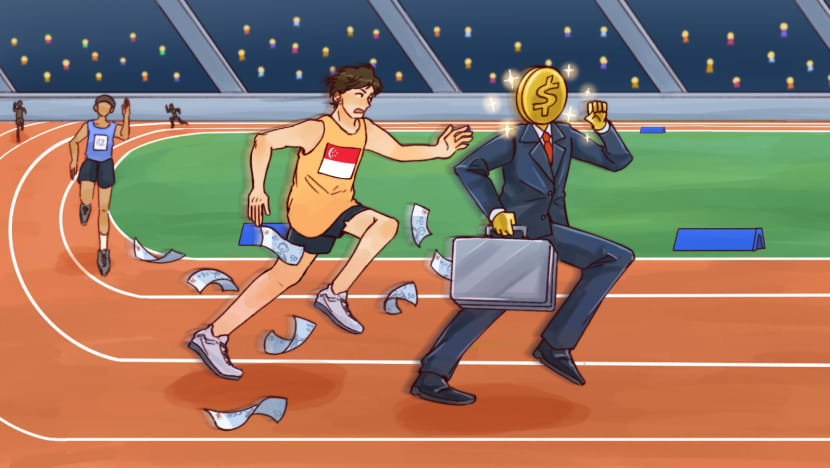
Securing corporate sponsors can be a struggle in Singapore's sports scene. (Illustration: CNA/Clara Ho)

This audio is generated by an AI tool.
SINGAPORE: When Singaporean water polo player Lee Kai Yang first reached out to companies in 2017 to form partnerships, many were reluctant.
The national team captain and three-time Southeast Asian Games gold medallist was looking for help to cover expenses related to his sport, but soon realised “brands didn’t understand athletes”.
“They just saw me as any other influencer. And if I were to just pit myself against any other influencer, I’m nowhere near,” he said, adding that the companies cared more about his number of followers and how popular he was on social media.
“That was something that I was very frustrated with in the beginning.”
Over the years, elite athletes like Lee as well as some national sports associations (NSAs) have struggled to secure private sector funding, as CNA found in interviews with several stakeholders in Singapore’s sporting ecosystem.
Uneven levels of visibility and interest in different sports have been some contributing factors. Experts offered suggestions going forward, ranging from national-level initiatives to a focus on individual storytelling, as NSAs themselves continue to find ways to make things work.
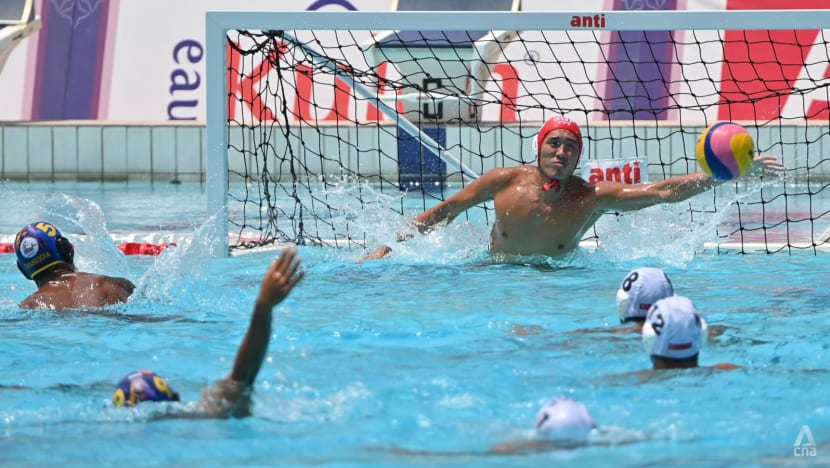
A “DEPRESSING” PICTURE?
No public information exists on the aggregated ratio of private to government funding in sport in Singapore.
In 2017, it was revealed that governing body Sport Singapore (SportSG) provided funding to 45 out of 63 eligible NSAs, to support their organisation functions, outreach programmes, training facilities and high-performance sports plans.
More recently, the government in 2022 said it had pumped about S$70 million (US$54.5 million) into the national high-performance sport system. A handful of national scholarship schemes also offer financial support to athletes.
To get corporates on board, a One Team Singapore Fund was launched in 2017, with the government matching dollar-for-dollar donations to back national athletes.
Among early contributors to the fund were Deloitte and Fullerton Health, which pledged S$150,000 and S$250,000 respectively. More than 90 corporates have contributed to the fund since, said SportSG in response to CNA's queries to authorities on private sector funding.
A spokesperson also pointed to the Singapore National Olympic Council’s Major Games Awards Programme or MAP, a cash incentive scheme supported by the government's Tote Board but funded by private sponsors. Singapore’s S$1 million Olympic gold medal payout, under MAP, is known to be the highest globally.
A scholarship supported by Singaporean tycoon Peter Lim has also given out more than S$11 million to thousands of local athletes since its inception in 2010.
SportSG told CNA that donations to the sports sector increased from S$7.9 million in FY2021 to S$13 million in FY2023. But this was the lowest among all sectors, accounting for less than 1 per cent of all donations that financial year.
Deloitte Southeast Asia’s sports business group leader James Walton said that apart from a “core” group of large local firms such as DBS and OCBC banks as well as SingTel lending their financial muscle to sport, the overall picture was a “pretty depressing” one.
“I think there’s a bit of stigma; there’s a perception issue here that when somebody says ‘do you want to sponsor sports?’ – for a lot of people it’s a ‘no’ before there’s even any discussion.”
Former Singapore Sports Hub chief executive officer Oon Jin Teik argued that in the last two decades, there has been a “diversification and professionalisation” of sports sponsorship here.
But he acknowledged that while major events such as the Formula 1 Singapore Grand Prix have attracted international sponsors, challenges persist at the grassroots and semi-professional levels, with many local sports organisations struggling to secure “consistent and substantial” corporate backing.
SPONSORS ALWAYS “BACK OF MIND”
Former national fencer and sports administrator Nicholas Fang told CNA that “if you only put your hand out to the government, the government cannot pay for everything”.
But at the same time, not all NSAs are capable of securing sponsorships on their own, he added.
Even for those with the know-how, there are other difficulties. For some, it starts with trying to promote sports that lack mass interest in Singapore.
The Singapore Sailing Federation, for one, has to get through “a lot of nos” before getting a yes, said chief executive officer Leslie Tan.
“In some ways, sailing is not a sport that you can easily understand … as quickly as some other sports,” he added.
While the search for sponsors is always on "the back of the mind" for the Singapore Canoe Federation (SCF), it also often faces a lack of awareness of the multiple sports under its umbrella – from sprint kayaking to stand-up paddling, among others.
“Corporate sponsors are an essential piece,” said its general manager Matt Lee, noting that they help an NSA move towards building its own revenue streams and eventually becoming more self-sustaining.
For Olympic wrestling, which doesn’t have a large local following, sponsors are often former athletes; people with connections to countries with strong background in the sport; or family members of wrestlers themselves, a spokesperson for the Wrestling Federation of Singapore told CNA.
And given that rugby’s visibility is not high locally, the Singapore Rugby Union, too, taps on existing connections to bring in new sponsors, said its general manager Sidney Kumar.
“If your sport is not popular, then you have to try harder. If your sport is popular, you have to make sure it remains popular,” added Professor David Tan, vice-president of business development and communications at the Singapore Badminton Association.
Even for golf, perceived by some as a sport for the affluent, there can be potential challenges in dealing with corporations and their expectations for returns on investment (ROI) – which can include opportunities to interact with top professionals.
“Sponsors also naturally gravitate toward world-class athletes and events, making it more challenging to secure sponsorships for developing athletes or grassroots programmes,” said the Singapore Golf Association’s chief executive officer Joshua Ho.
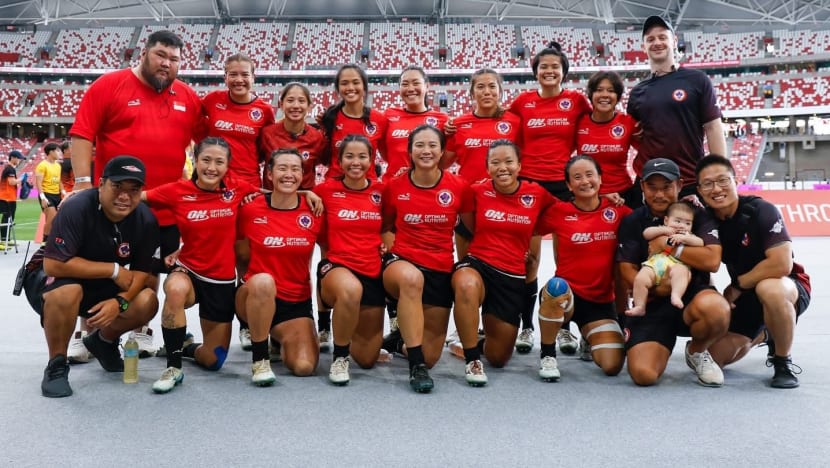
“BANG FOR THEIR BUCK”
Asked what else could be holding corporations back, Deloitte’s Mr Walton said Singapore’s small domestic market doesn’t help when companies are looking to get “bang for their buck” from a marketing point of view.
He cited regional neighbours Indonesia, Philippines, Thailand, Vietnam and Malaysia as larger markets “which lend themselves more to a B2C (business to consumer) play and a potential ROI”.
For Indonesia’s football federation, approximately 70 per cent of funding comes from the private sector. In comparison, 80 per cent of the Football Association of Singapore’s funding in the last financial year came from SportSG.
In the Philippines, where basketball is most popular, funding comes from private corporations rather than the government. Teams in the country’s professional league are also owned by conglomerates and companies.
SportSG highlighted to CNA that in Thailand, several major corporations sponsor national teams; while in Japan and Korea, companies own and fund sports teams.
Another factor is Singapore’s sporting culture – or lack of a strong one.
“A vibrant sporting culture not only boosts participation rates but also generates passionate fandom, media coverage and community narratives,” said Mr Oon, himself an Olympian in swimming.
“In Singapore, while interest in certain sports … football, badminton, swimming … is strong, the overall sporting culture remains less fervent than in more sports-centric societies, affecting sponsorship prospects.”
Mr Walton warned of a knock-on effect of funding sources drying up.
“Without the investment, you create a vicious circle where the teams are not going to get better, the leagues are not going to get better, and the management and governance also does not get better,” he said.
“Because with less money in the system, it's more difficult to hire good people, retain good people, and have the levels of staffing that you need to have to properly run the sports as well.”
THE “BIGGER PICTURE”
CNA interviewed multiple companies which have partnered Singapore’s sports organisations and athletes. They spoke of wanting to contribute to society and to bridge any gaps left by insufficient public funding – but acknowledged that they also stood to gain visibility and other upsides from such deals.
Take Adonis Skincare and the Major 99 karaoke and entertainment centre, two SMEs throwing their weight behind the relatively niche sport of tchoukball – with an eye on reaching youths.
“Sports is a good way to connect with the younger generation,” said Mr Shane Cheng, founder of Major 99, which got roped in via the Ang Mo Kio Constituency Merchants Association. “I feel that new and emerging sports is where Singapore (can have a) competitive edge.”
The Tchoukball Association of Singapore’s secretary Delane Lim said the strategy was always to look for smaller, local firms to partner with and “create a village”.
“It also provides messaging to other SMEs that ‘actually, I don’t need to be a multi-million dollar SME to be part of sports’,” he said.
Then there’s Sunrise & Company, the Singapore distributor for the Yonex brand and a fixture in the local scene for decades now.
It started partnering the SNOC from the 1973 Southeast Asian Peninsular (SEAP) Games, providing tracksuits for participating athletes and officials. Yonex-branded tracksuits and backpacks have been a constant companion to Singapore’s athletes at major Games since.
“We believe supporting athletes and being part of Singapore's sporting journey builds our brand in meaningful ways,” said Sunrise & Company’s head of promotions Shaan Seth. “The most valuable investments are the ones that build relationships with the community over time, and we think doing the right thing is good business in the long run.”
That approach is shared by Yeo’s, a major player in the local sports scene.
The beverage company signed a three-year partnership with kitefoiler and Olympic bronze medallist Maximilian Maeder in 2022, and recently extended it by another four years. As part of the new deal, it pledged another S$180,000 to the sailing federation, which will be matched by the OTSF.
“We do not measure our bottom line by short-term monetary gain alone,” said Yeo’s chief executive officer Ong Yuh Hwang. "We practice the philosophy of wanting to 'do good business and do good in business'."
Maeder told CNA that a key consideration was whether the sponsorship would also help sports in Singapore at large.
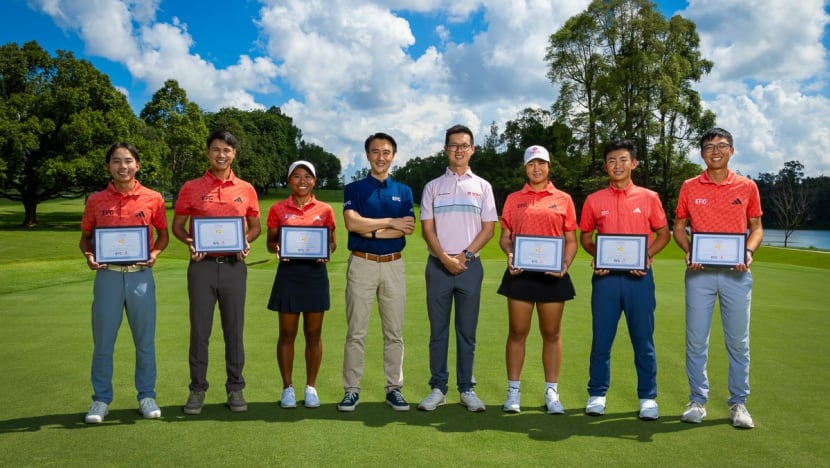
Mr Albert Chiu, Swiss private bank EFG’s executive chairman for Asia-Pacific, also spoke of eschewing narrow views in favour of “the bigger picture”.
The Singapore branch of the bank first got involved in golf in 2018, sponsoring Koh Sock Hwee, one of Singapore’s first female professional touring golfers. It then partnered the NSA to set up an elite young golfers scholarship programme.
“I can understand why some corporations may have reservations in investing in local sport in Singapore. It is a relatively small market, and its commercial impact might not seem immediately apparent compared to more established sporting nations,” said Mr Chiu.
But EFG’s experience supporting golf in Singapore has been overwhelmingly positive, he said.
“Sport has the ability to unite a nation. As we have all experienced with Joseph Schooling’s gold medal and Max Maeder’s bronze, these are nation-defining moments.”
The SGA’s corporate sponsorship income has grown by more than fourfold over the past three years.
It has three main corporate income streams – sponsorships for programmes (such as high-performance or junior development), sponsorships for events, and donations from fundraising activities.
Together, these contribute to about a third of the NSA’s total annual income.
Income Insurance chief customer officer Dhiren Amin also noted that companies tend to sponsor sports and sporting talents that are already doing well.
But his firm recognises that this is a "chicken and egg" issue. Without funding, athletes could be unable to train full-time or have the opportunity to achieve their full potential, he said.
“In working with (Singapore Athletics), we provide some level of flexibility for them to identify where the gaps are that require support, and channel the funds to fill (them),” said Mr Dhiren.
The company is a major partner of Singapore Athletics. Last year, it announced an annual sponsorship of S$100,000 as part of a development fund for the next five years, building on an earlier agreement to provide cash sponsorship and insurance coverage for more than 120 athletes and staff members.
DBS, which backs the Sailing at the Bay programme and is one of the primary sponsors of the Singapore National Paralympic Council's Athletes Achievement Awards (AAA), said its support was not "conditional" on athletes' achievements.
"What matters to us is their character and commitment," said Ms Karen Ngui, head of DBS Group strategic marketing and communications.
"At its core, this is why we support athletes: They embody and reflect key values that we believe in, and we hope everyone – be it aspiring athletes or the wider public – can draw inspiration and strength from their journeys, just as we do."
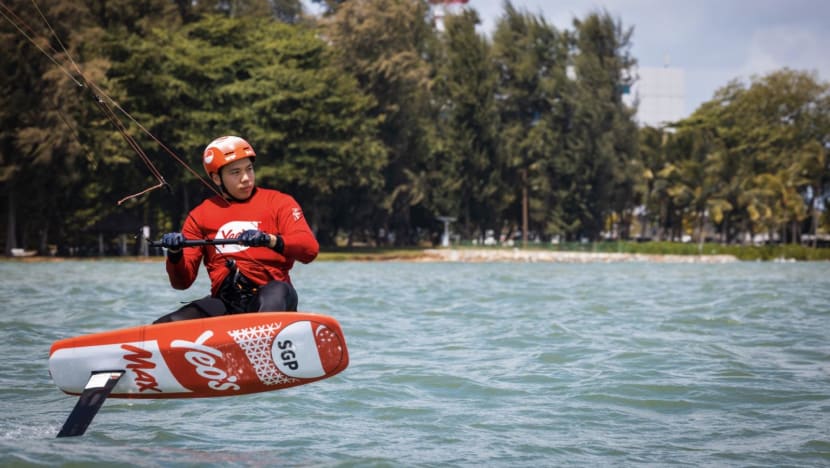
STORY SELLING
There is much more that stakeholders up and down the ecosystem can do, experts told CNA.
Mr Oon suggested that SportSG set up a national sponsorship platform, describing it as a unified, government-backed vehicle to match sponsors with teams, athletes and events.
It would be a centralised source of information, guidelines and opportunities – streamlining the sponsorship process and lowering barriers for new entrants, he said.
The golf association’s Mr Ho called on NSAs to view sponsorships less as “one-way support” and more as partnerships.
“NSAs need to communicate the value of sponsorships clearly and show how they can value-add in creative ways,” he said.
One way his association has done so is to organise introductory golf sessions for sponsors’ clients and employees, conducted by the sponsored athletes.
“Through such activities, athletes also have the opportunity to share their personal journeys, helping sponsors and their stakeholders better understand the dedication and challenges in an athlete’s career,” said Mr Ho.
The stories behind each athlete and sport are pivotal – with or without the medals to accompany them, said those who spoke with CNA.
Mr Walton from Deloitte, which used to sponsor the football Women’s Premier League, said: “Storytelling around adversity, challenges, triumph, teamwork, diversity, opportunities for youth, bringing the community together – all of those are in my branding strategy”.
Singapore Athletics said it has seen a “significant” increase in interested corporate sponsors, with its number of partners growing from five at the start of 2023 to 11 today.
“This surge is fuelled by the outstanding performances of our athletes in recent years, including record medal hauls at major Games and a sharp increase in national records being broken,” said a spokesperson.
“Athletes such as Shanti Pereira have also risen to star status, putting our sport in the national spotlight and making it more attractive to potential partners.”
The rise of badminton world champion Loh Kean Yew has also helped the NSA, with vice-president Prof Tan calling it a “tsunami effect” that has attracted sponsors in its wake.
About 55 per cent of the badminton association’s annual income comprises funding from SportSG, with the rest sourced from corporate sponsorships and commercial revenues that include events and facilities’ rental.
At the sailing federation, which has benefited from kitefoiler Maeder’s rise to prominence, the goal is to showcase and tell the stories of all athletes, regardless of success.
“There's also the story of trying to get to the pinnacle.. It’s not all podium and medals,” said Singapore Sailing CEO Mr Tan. “I've been trying to market or provide that story as well to other sponsors. It's a continual search, I think it will take a particular type of sponsor who wants to get behind this story.”
Mr Fang, who had to canvass sponsors when he was an athlete himself, said sportspeople also need to be "proactive" about getting corporate funding.
“One big positive change has been social media. Now every athlete has their own platform, it’s just a question of how they want to optimise it to be of value for brands to want to associate themselves with the athletes as well,” said the director of local sports consultancy Novastella.
One standout in this regard is perhaps distance runner Soh Rui Yong.
The multiple national record holder and SEA Games medallist has partnerships with brands such as Hugo Boss, Pocari Sweat and Under Armour.
He told CNA that while it was important to be his “unique authentic self”, he also has to see from a potential sponsor’s perspective what he brings to the table.
“You need to stand out from the crowd in some way,” he said. “(And sponsors) have to see the value in you – either that or you have good connections … It’s hard.”
Eight years on from his first attempts to get sponsored, water polo player Lee is making things work.
In part, this is by helping brands better understand athletes: He now goes into pitches with a slide deck spelling out his sporting achievements and core values.
“I realised I needed to educate brand partners about my USP (unique selling point),” he said.
“And in general, my USP is really about being able to add that level of reputation on top of whatever general marketing they are doing.
“I always angle it as a collaboration – the mindset coming in (for the company) is that it is going to be a win-win partnership.”
Lee has in recent years inked deals with a number of partners, totalling about S$50,000 in cash and kind. The brands range from interior design firm My Reno Diary to mattress company Tempur.
This maturing of Singapore’s sports scene, across athletes and commercial entities alike, is cause for optimism, said experts.
“We’re seeing the needle move a little bit; we’re seeing more corporates getting excited about sports and the opportunities,” said Mr Fang.
“But we really need to embed sports; sporting culture into our national DNA before we’ll see sponsors coming to knock on the doors of NSAs or sports events … rather than the other way around.
“We have some way to go.”


















